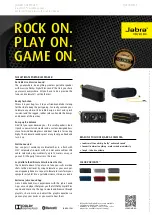
UNAOHM
NG500 (Rev. 0)
9
6.3.
HOW TO CONNECT THE GENERATOR TO THE DEVICE UNDER TEST
To transfer the signal from the generator to the device under test, use a coaxial cable with good
electrical characteristics.
It is also important for the termination to match the characteristic impedance of the 75
Ω
coaxial
cable (for 50
Ω
output impedance use a coaxial cable and a 50
Ω
termination).
An unsuitable cable provokes frequency cuts and standing waves which strongly affects the
frequency response.
7.
MAIN APPLICATIONS
The NG 500 allows for numerous measurements among which:
# Attenuation of the coaxial cables and related frequency response.
# Attenuation of pass, pick-up and decoupling of resistive or inductive shunters.
# Pass band or channel filters.
# Stop band or channel filters.
# Wide band amplifiers.
# Selective pass band or channel amplifiers.
# Frequency converters.
# Response of a complete installation/distribution system.
# Localization of open circuits, short circuits, or a considerable mismatch on a cable.
For the most important of these measurements which can, in turn, be used for taking all the other
ones, we will indicate how to make the set up of the units, which precautions should be taken
and any warnings to take into consideration to avoid the risk of incorrect measurements. The
appendix will deal with them in more detail together with some technical matters related to the
measurements carried out.
7.1.
FREQUENCY RESPONSE MEASUREMENT
A simplified structure of a typical centralized installation is given in figure 3.
Note the antenna, headend and the distribution network to which the TV sets are connected.
There are active elements (wideband or selective amplifiers and converters) and passive
elements (mixers, band attenuators, pass channel or band filters) in the headend.
The distribution network delivers the output signals from the headend to the users’ outlets, with
passive elements composed of dividers, shunters, the coaxial cable and the outlets (terminated
and/or cascaded).
For satisfactory reception of the TV signals the distribution response must not introduce
important distortions in level with respect to frequency.
The attenuation, i.e. the reduction of the signal level during transit, increases with the frequency.
It is therefore important to keep attenuation under control.
Two instruments are necessary to carry out the measurement: the NG 500 noise generator and a
field strength meter fitted with a spectrum analyser, that will be referred to further on in this
manual as FSM.






































